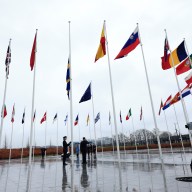It’s taken 15 blown budgets in the past 20 years and a record-breaking season of complaints about winter driving conditions for council to send our snow removal program back to the drawing board. I wonder if we will ever have the mindset to get it right.
Ald. Brian Pincott, chair of the city’s audit committee, called for an audit after months of scattered suggestions failed to address the perennial problem of snowdrifts and slick streets.
Pincott’s plan will see a panel of citizens and council members weigh in with interim findings by July and a final review by late November when the next budget is set.
I’ve got one suggestion for the panel and one for Calgarians.
To the panel — let’s give all forms of transportation equal weight at the table. Our current system sees snow plowed from roads into bike lanes, atop sidewalks and in front of bus stops.
Why is it that drivers should travel in a safer manner than cyclists and pedestrians? Sure, the city has an existing priority system that concentrates efforts on high traffic areas first, including pedestrian hot spots downtown, major bus routes and expressways. We’re even fortunate enough to have 130 kilometres of our pathways cleared during the winter.
Despite this, residents with mobility issues can’t reliably get around, accessing transit is all too often cumbersome, and cyclists already braving wintery conditions are met with additional hazards.
It’s a simple argument — whatever clearing measures are provided to motorized vehicles should be provided in equal measure to non-motorized forms of transport.
And to Calgarians — a reminder there’s one reason we’re in this mess that’s not being discussed. True, we’ve got a climate that quite often buries us in snow, but that’s not within our control — our size, however, is.
Our tax dollars are spread too thin over too far a distance. The city has more than 14,000 lane kilometres of roads to clear and only 1,435 residents per square kilometre to pay for them, four times less dense than a city like Vancouver.
Compounding the problem, municipal taxes are based on market assessments that value inner city properties higher than those in the suburbs. Suburbanites should be paying more though since infrastructure costs for sparsely populated, far reaching areas are exponentially greater.
I’d like to put the topic of snow removal to rest with all forms of transportation given equal consideration and all residents paying their fair share.
















